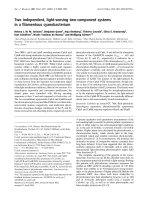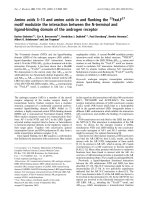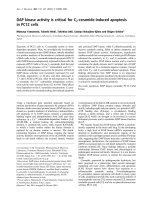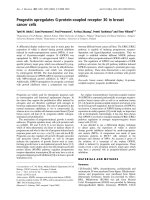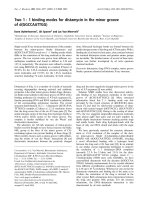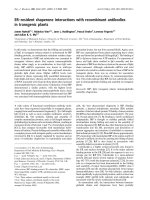Báo cáo y học: "Oberlin partial ulnar nerve transfer for restoration in obstetric brachial plexus palsy of a newborn: case report" pot
Bạn đang xem bản rút gọn của tài liệu. Xem và tải ngay bản đầy đủ của tài liệu tại đây (908.92 KB, 5 trang )
BioMed Central
Page 1 of 5
(page number not for citation purposes)
Journal of Brachial Plexus and
Peripheral Nerve Injury
Open Access
Case report
Oberlin partial ulnar nerve transfer for restoration in obstetric
brachial plexus palsy of a newborn: case report
Koji Shigematsu*, Hiroshi Yajima, Yasunori Kobata, Kenji Kawamura,
Naoki Maegawa and Yoshinori Takakura
Address: Department of Orthopaedic Surgery, Nara Medical University, Nara, Japan
Email: Koji Shigematsu* - ; Hiroshi Yajima - ; Yasunori Kobata - ykobata@naramed-
u.ac.jp; Kenji Kawamura - ; Naoki Maegawa - ; Yoshinori Takakura - ytakakaura@naramed-
u.ac.jp
* Corresponding author
Abstract
An 8 month old male infant with Erb's birth palsy was treated with two peripheral nerve transfers.
Except for rapid motor reinnervations, elbow flexion was obtained by an Oberlin's partial ulnar
nerve transfer, while shoulder abduction was restored by an accessory-to-suprascapular nerve
transfer. The initial contraction of the biceps muscle occurred two months after surgery. Forty
months after surgery, elbow flexion reached M5 without functional loss of the ulnar nerve. This
case demonstrates an excellent result of an Oberlin's nerve transfer for restoration of flexion of
the elbow joint in Erb's birth palsy. However, at this time partial ulnar nerve transfer for Erb's birth
palsy is an optional procedure; a larger number of cases will need to be studied for it to be widely
accepted as a standard procedure for Erb's palsy at birth.
Background
In 1994, Oberlin et al. [1] described a new technique of
partial ulnar nerve transfer to the biceps muscle nerve for
restoration of elbow flexion in traumatic C5-C6 avulsion
of the brachial plexus in adult. We report treating an eight
month old male infant without C5 to C6 function by an
Oberlin's partial ulnar nerve transfer and an accessory-to-
suprascapular nerve transfer.
Case presentation
An 8 month old male infant with obstetric brachial plexus
palsy associated with a breech delivery (at 40 weeks 1 day,
birth weight: 3535 g), was treated by peripheral nerve
transfer. He was complicated with phrenic nerve palsy,
and a surgical treatment (reefing of the diaphragm) for
this lesion had been undertaken at two months of age in
another institute. At the first examination in our institute
(at 5 months of age), active shoulder abduction and
elbow flexion were absent (Fig. 1). Mental and other
motor functional developments were normal. During 3
months of observation, no spontaneous recovery of
elbow flexion or shoulder abduction was shown. On elec-
trophysiological evaluations, no action potential of the
neuromuscular unit was revealed in the biceps and del-
toid muscles. The action potential of the neuromuscular
unit of the abductor pollicis brevis muscle showed a nor-
mal wave. Physical and electrical examinations revealed
an upper trunk type (C5-C6) right-side plexopathy. We
considered the possibility of spontaneous recovery for
several months, but functional recovery was poor. An
Published: 29 September 2006
Journal of Brachial Plexus and Peripheral Nerve Injury 2006, 1:3 doi:10.1186/1749-7221-1-
3
Received: 09 March 2006
Accepted: 29 September 2006
This article is available from: />© 2006 Shigematsu et al; licensee BioMed Central Ltd.
This is an Open Access article distributed under the terms of the Creative Commons Attribution License ( />),
which permits unrestricted use, distribution, and reproduction in any medium, provided the original work is properly cited.
Journal of Brachial Plexus and Peripheral Nerve Injury 2006, 1:3 />Page 2 of 5
(page number not for citation purposes)
Oberlin's nerve transfer and an accessory to suprascapular
nerve transfer were selected to facilitate a rapid motor
functional recovery of the biceps and deltoid muscles.
Under general anesthesia, an operation was performed in
the supine position. The brachial artery and the median,
ulnar, and a branch of the musculocutaneous nerve sup-
plying the biceps muscle were identified at a level approx-
imately 7.0 cm distal from the acromion. One fascicle of
the ulnar nerve was separated at the same level as the
branch of the biceps muscle. We confirmed a fascicle cor-
responding to the motor fascicle of the ulnar nerve by
microelectronic stimulation, and we then transferred this
fascicle to the motor branch of the biceps muscle [1,2].
End-to-end nerve repair, at a level approximately 1.0 cm
proximal from the insertion to the biceps muscle, was
then performed using 10-0 sutures (Fig. 2). After resection
of the omohyoid muscle, the upper trunks appeared. The
spinal accessory nerve and the suprascapular nerve were
identified, and the spinal accessory nerve was then trans-
ferred to the suprascapular nerve. The duration of these
procedures was two hours and forty minutes. After sur-
gery, the upper arm of the operative site was set free with
no cast immobilization. No specific motor re-education
program was used post-operatively.
A primary contraction of the biceps muscle appeared two
months after nerve transfer (British Medical Research
Council grading (MRC): M1). Full ranged elbow flexion
(MRC: M4), and 90 degree shoulder abduction (MRC:
M3), were obtained five months after surgery. Forty
months after surgery, the ranges of both elbow flexion,
M5, and shoulder abduction, M4, were full However,
these muscles were somewhat weak compared with the
contralateral site. Sensation in the ulnar nerve distribu-
An eight-month-old boy with Erb's palsy at birth had no shoulder abduction or elbow flexion against gravityFigure 1
An eight-month-old boy with Erb's palsy at birth had no shoulder abduction or elbow flexion against gravity.
Journal of Brachial Plexus and Peripheral Nerve Injury 2006, 1:3 />Page 3 of 5
(page number not for citation purposes)
tion in the hand was obscure, though the patient did not
complain of any discomfort in the hand.
Discussion
In 2002, the first two cases using Oberlin's nerve transfer
(at 16 and 18 months after birth) for Erb's birth palsy of
the C5-C6 type were reported by Al Quattan [3]. In 2004,
Noaman et al. [4] followed this treatment method for 7
obstetric brachial plexus palsies with no elbow flexion (at
11 to 24 months after birth). This report supplements
those reports and details a case younger (8 months after
birth) than previous cases. Spontaneous recovery of
obstetric brachial plexus palsy occasionally occurs;
reported rates vary widely, ranging from 7 per cent to 96
per cent. Complete recovery can be expected only if the
muscles start contracting by the first month [5]. Tassin [6]
treated forty-four brachial plexus palsy cases due to
obstetric lesion without surgical treatment; suggesting
that primary surgical repair of the brachial plexus was war-
ranted if recovery of the biceps had not began at three to
four months of age, because in such cases functional prog-
nosis was considered poor. Based on these reports, we per-
formed peripheral nerve transfers at 8 months of age.
In our case, primary contraction of the biceps muscle
appeared at 8 weeks after nerve transfer. In previous cases,
initial biceps motor return was noted at 12 and 14 weeks,
respectively, after surgery [1]. Motor reinnervation of the
biceps muscle occurs within two to three months after
partial ulnar nerve transfer, and thus elbow flexion is
restored before permanent atrophy of the muscle occurs.
In adult, Leechavengvongs et al. [2] performed partial
ulnar nerve transfer for thirty-two patients with brachial
plexus palsy. They reported that initial recovery was noted
Intraoperative view of the partial ulnar nerve transfer to the musculocutaneous branch of the biceps muscleFigure 2
Intraoperative view of the partial ulnar nerve transfer to the musculocutaneous branch of the biceps muscle. The forceps indi-
cate one fascicle of the ulnar nerve. UN; ulnar nerve. MB; motor branch of the musculocutaneous nerve. BM; biceps muscle.
Journal of Brachial Plexus and Peripheral Nerve Injury 2006, 1:3 />Page 4 of 5
(page number not for citation purposes)
at 2 to 5 months after surgery (mean 3), and also
described a functional recovery rate of 93% (patients
achieving M4 or better), which compares favorably with
other reported methods of brachial plexus neurotization
[7]. Moreover, partial ulnar nerve transfer was possible to
undertake with just one incision at the middle upper arm;
whereas other procedures require many large incisions. A
lower level of invasiveness is one of the advantages of this
method, as well as motor reinnervation of the muscle
being faster than other procedures.
Noaman et al. [4] noted four indications of partial ulnar
nerve transfer for upper obstetric brachial plexus palsy; 1)
breech delivery with avulsion of C5 and C6 nerve roots. 2)
late presentation with good recovery of shoulder function.
3) spontaneous recovery of the upper obstetric brachial
plexus palsy without biceps function, and 4) neuroma-in-
continuity of the upper trunk, with good intraoperative
shoulder muscle nerve condition, the same as a preopera-
tive good shoulder function but with no biceps action.
Our case would not have satisfied their criteria. The
patient had not recovered elbow flexion and shoulder
abduction at 8 months after birth; therefore, it was neces-
sary to rapidly restore flexion of the elbow joint and to sta-
bilize the shoulder joint. Stabilization of the shoulder
joint was achieved by accessory to suprascapular nerve
transfer. For restoration of the flexion of the elbow joint,
there are several operations. Intracostal nerve transfer [7]
is one of the procedures to restore flexion of the elbow
joint. However, the patient in this case had had phrenic
nerve palsy and an operation had already been per-
formed. Intracostal nerve transfer for a patient with
phrenic nerve palsy is a danger because a respiratory dis-
turbance sometimes occurs post-operatively. Nerve graft-
ing is a useful procedure for restoration of flexion of the
elbow joint, but motor reinnervation comes later than in
Forty months after surgeryFigure 3
Forty months after surgery. The elbow joint can flex over a full range of active motion, the same as the contralateral side. The
shoulder is stable, but atrophy of the deltoid muscle is seen (white arrow).
Publish with BioMed Central and every
scientist can read your work free of charge
"BioMed Central will be the most significant development for
disseminating the results of biomedical research in our lifetime."
Sir Paul Nurse, Cancer Research UK
Your research papers will be:
available free of charge to the entire biomedical community
peer reviewed and published immediately upon acceptance
cited in PubMed and archived on PubMed Central
yours — you keep the copyright
Submit your manuscript here:
/>BioMedcentral
Journal of Brachial Plexus and Peripheral Nerve Injury 2006, 1:3 />Page 5 of 5
(page number not for citation purposes)
partial ulnar nerve transfer. Thus, we selected a partial
ulnar nerve transfer despite the intercostal nerve transfer
and nerve grafts.
Conclusion
This case demonstrates an excellent result of an Oberlin's
nerve transfer for restoration of flexion of the elbow joint
in Erb's birth palsy. However, at this time partial ulnar
nerve transfer for Erb's birth palsy is an optional proce-
dure; a larger number of cases will need to be studied for
it to be widely accepted as a standard procedure for Erb's
palsy at birth.
References
1. Oberlin C, Beal D, Leechavengvongs S, Salon A, Dauge MC, Sarcy JJ:
Nerve transfer to biceps muscle using a part of ulnar nerve
C5-6 avulsion of the brachial plexus; anatomical study and
report of four cases. J Hand Surg (Am) 1994, 19:232-237.
2. Leechavengvongs S, Witoonchart K, Uerpairojkit C, Thuvasethakul P,
Ketmalasiri W: Nerve transfer to biceps muscle using a part of
the ulnar nerve in brachial plexus injury (upper arm type): a
report of 32 cases. J Hand Surg (Am) 1998, 23:711-716.
3. Al-Qattan MM: Oberline's Ulnar Nerve Transfer to the Biceps
Nerve in Erb's Birth Palsy. Plast Reconstr Surg 2002, 109:405-407.
4. Noaman HH, Shiha AE, Bahm J: Oberlin's ulnar nerve transfer to
the biceps motor nerve in obstetric brachial plexus palsy:
Indications, and good and bad results. Microsurgery 2004,
24(3):182-7.
5. Terzis JK, Papakonstantinou KC: Management of obstetric bra-
chial plexus palsy. Hand Clin 1999, 15:717-736.
6. Tassin JL: Paralysies obstétricales du plexus brachial: evolu-
tion spontanée, résultats des interventions réparatrices pré-
coces. In Thesis Université Paris VII; 1983.
7. Narakas AO, Hentz VR: Neurotization in brachial plexus inju-
ries: indication and results. Clin Orthop Relat Res 1988:43-56.
8. Nagano A: Direct nerve crossing with the intercostal nerve
treat avulsion injuries to the brachial plexus. J Hand Surg (Am)
1989, 14:980-985.



